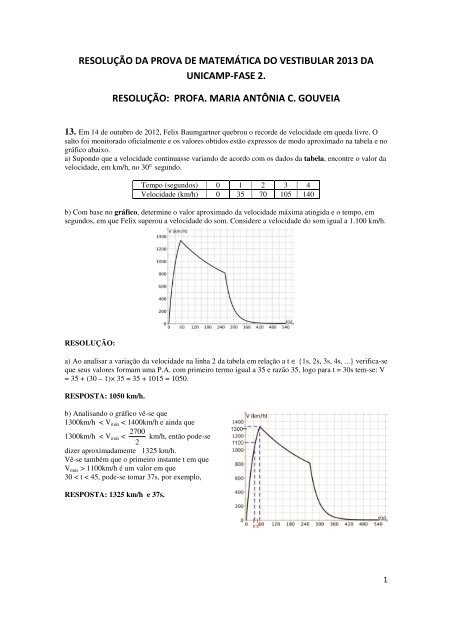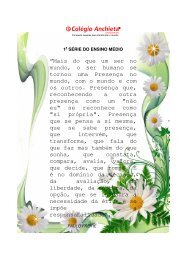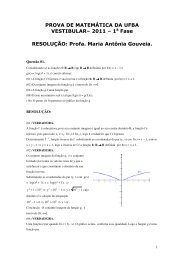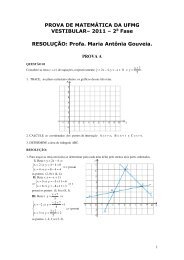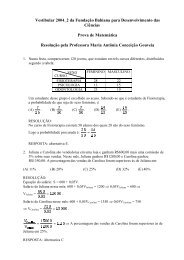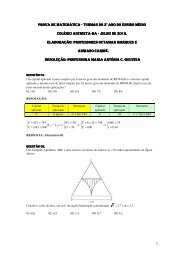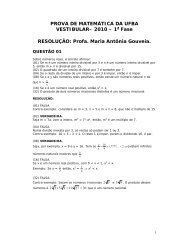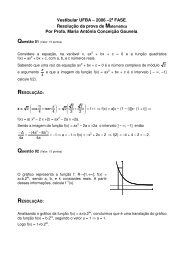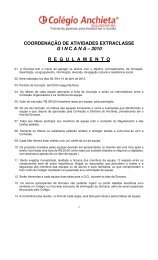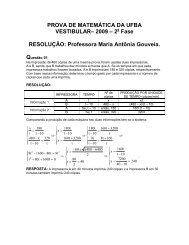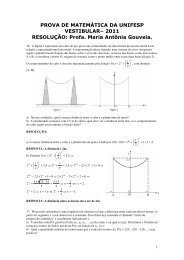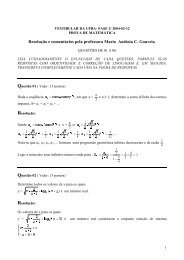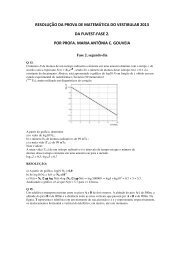resolução da prova de matemática do vestibular 2013 da unicamp ...
resolução da prova de matemática do vestibular 2013 da unicamp ...
resolução da prova de matemática do vestibular 2013 da unicamp ...
Create successful ePaper yourself
Turn your PDF publications into a flip-book with our unique Google optimized e-Paper software.
RESOLUÇÃO DA PROVA DE MATEMÁTICA DO VESTIBULAR <strong>2013</strong> DA<br />
UNICAMP-FASE 2.<br />
RESOLUÇÃO: PROFA. MARIA ANTÔNIA C. GOUVEIA<br />
13. Em 14 <strong>de</strong> outubro <strong>de</strong> 2012, Felix Baumgartner quebrou o recor<strong>de</strong> <strong>de</strong> veloci<strong>da</strong><strong>de</strong> em que<strong>da</strong> livre. O<br />
salto foi monitora<strong>do</strong> oficialmente e os valores obti<strong>do</strong>s estão expressos <strong>de</strong> mo<strong>do</strong> aproxima<strong>do</strong> na tabela e no<br />
gráfico abaixo.<br />
a) Supon<strong>do</strong> que a veloci<strong>da</strong><strong>de</strong> continuasse varian<strong>do</strong> <strong>de</strong> acor<strong>do</strong> com os <strong>da</strong><strong>do</strong>s <strong>da</strong> tabela, encontre o valor <strong>da</strong><br />
veloci<strong>da</strong><strong>de</strong>, em km/h, no 30 o segun<strong>do</strong>.<br />
Tempo (segun<strong>do</strong>s) 0 1 2 3 4<br />
Veloci<strong>da</strong><strong>de</strong> (km/h) 0 35 70 105 140<br />
b) Com base no gráfico, <strong>de</strong>termine o valor aproxima<strong>do</strong> <strong>da</strong> veloci<strong>da</strong><strong>de</strong> máxima atingi<strong>da</strong> e o tempo, em<br />
segun<strong>do</strong>s, em que Felix superou a veloci<strong>da</strong><strong>de</strong> <strong>do</strong> som. Consi<strong>de</strong>re a veloci<strong>da</strong><strong>de</strong> <strong>do</strong> som igual a 1.100 km/h.<br />
RESOLUÇÃO:<br />
a) Ao analisar a variação <strong>da</strong> veloci<strong>da</strong><strong>de</strong> na linha 2 <strong>da</strong> tabela em relação a t ∈ {1s, 2s, 3s, 4s, ...} verifica-se<br />
que seus valores formam uma P.A. com primeiro termo igual a 35 e razão 35, logo para t = 30s tem-se: V<br />
= 35 + (30 – 1)× 35 = 35 + 1015 = 1050.<br />
RESPOSTA: 1050 km/h.<br />
b) Analisan<strong>do</strong> o gráfico vê-se que<br />
1300km/h < V máx < 1400km/h e ain<strong>da</strong> que<br />
2700<br />
1300km/h < V máx < km/h, então po<strong>de</strong>-se<br />
2<br />
dizer aproxima<strong>da</strong>mente 1325 km/h.<br />
Vê-se também que o primeiro instante t em que<br />
V máx > 1100km/h é um valor em que<br />
30 < t < 45, po<strong>de</strong>-se tomar 37s, por exemplo,<br />
RESPOSTA: 1325 km/h e 37s.<br />
1
14. Os la<strong>do</strong>s <strong>do</strong> triângulo ABC <strong>da</strong> figura abaixo têm as seguintes medi<strong>da</strong>s AB = 20 , BC = 15 e<br />
AC = 10 .<br />
a) Sobre o la<strong>do</strong> BC marca-se um ponto D tal que BD = 3 e traça-se o segmento DE paralelo a AC. Ache<br />
a razão entre a altura H <strong>do</strong> triângulo ABC relativa ao la<strong>do</strong> AC e a altura h <strong>do</strong> triângulo EBD relativa ao<br />
la<strong>do</strong> ED, sem explicitar os valores h e H.<br />
b) Calcule o valor explícito <strong>da</strong> altura triângulo ABC em relação ao la<strong>do</strong> AC.<br />
RESOLUÇÃO:<br />
BC 15 H<br />
a) Como = = 3 ⇒ = 3 .<br />
BD 3 h<br />
RESPOSTA: 3.<br />
b) Do triângulo BCF: H 2 = 225 – x 2 e <strong>do</strong> triângulo BAF:<br />
H 2 = 400 – (10 + x) 2 . Logo: 225 – x 2 = 400 – (10 + x) 2 .<br />
225 – x 2 = 400 – (10 + x) 2 ⇒ 175 + x 2 – 100 – 20x – x 2 = 0 ⇒<br />
20x = 75 ⇒ x =<br />
15 2 225 3375 15<br />
⇒ H = 225 − ⇒ H<br />
2 = ⇒ H =<br />
4<br />
16 16<br />
RESPOSTA:<br />
15 15<br />
.<br />
4<br />
15<br />
4<br />
15. A superfície <strong>de</strong> um reservatório <strong>de</strong> água para abastecimento público tem 320. 000m 2 <strong>de</strong> área, formato<br />
retangular e um <strong>do</strong>s seus la<strong>do</strong>s me<strong>de</strong> o <strong>do</strong>bro <strong>do</strong> outro. Essa superfície é representa<strong>da</strong> pela região<br />
hachura<strong>da</strong> na ilustração abaixo. De acor<strong>do</strong> com o Código Florestal, é necessário manter ao re<strong>do</strong>r <strong>do</strong><br />
reservatório uma faixa <strong>de</strong> terra livre. Denomina<strong>da</strong> Área <strong>de</strong> Proteção Permanente (APP), como ilustra a<br />
figura abaixo. Essa faixa <strong>de</strong>ve ter largura constante e igual a 100m, medi<strong>do</strong>s a partir <strong>da</strong> bor<strong>da</strong> <strong>do</strong><br />
reservatório.<br />
a) Calcule a área <strong>da</strong> faixa <strong>de</strong> terra <strong>de</strong>nomina<strong>da</strong> APP nesse caso.<br />
b) Suponha que a água <strong>do</strong> reservatório diminui <strong>de</strong> acor<strong>do</strong> com a expressão V(t) = V 0 .2 – t , em que V 0 é o<br />
volume inicial e t é o tempo <strong>de</strong>corri<strong>do</strong> em meses. Qual é o tempo necessário para que o volume se reduza<br />
a 10% <strong>do</strong> volume inicial? Utilize, se necessário, log 10 2 ≈ 0,30.<br />
2
RESOLUÇÃO:<br />
a) A faixa <strong>de</strong> terra <strong>de</strong>nomina<strong>da</strong> APP é forma<strong>da</strong> por <strong>do</strong>is<br />
retângulos <strong>de</strong> dimensões (2x)m × 100m, <strong>do</strong>is retângulos<br />
xm × 100m e 4 semicírculos <strong>de</strong> 100m <strong>de</strong> raio.<br />
Como a superfície <strong>do</strong> reservatório <strong>de</strong> água tem 320. 000m 2<br />
<strong>de</strong> área, 2x.x = 320.000 ⇒ x 2 = 160.000 ⇒ x = 400 m.<br />
A área <strong>da</strong> faixa <strong>de</strong> terra <strong>de</strong>nomina<strong>da</strong> APP é então:<br />
S<br />
S<br />
APP<br />
APP<br />
2<br />
= 100 π + 2×<br />
800×<br />
100 + 2×<br />
400×<br />
100 ⇒<br />
= 10000π<br />
+ 240000 = 10000( π + 24).<br />
10000(<br />
24)<br />
RESPOSTA: 10000(π+ m 24)<br />
2 .<br />
b) Como o questionamento é “Qual é o tempo necessário para que o volume se reduza a 10% <strong>do</strong> volume<br />
inicial?”, tem-se:<br />
−t<br />
V0<br />
−t<br />
1<br />
−t<br />
⎛ 1 ⎞<br />
1 10 1<br />
V0<br />
.2 = ⇒ 2 = ⇒ log10<br />
(2 ) = log10<br />
⎜ ⎟ ⇒ −tlog10(2)<br />
= −1<br />
⇒ t = = = 3 ⇒<br />
10 10<br />
⎝10<br />
⎠<br />
0,3 3 3<br />
Aproxima<strong>da</strong>mente t = 3me10d<br />
RESPOSTA: t = 3me10d.<br />
16. A numeração <strong>do</strong>s calça<strong>do</strong>s obe<strong>de</strong>ce a padrões distintos, conforme o país. No Brasil, essa numeração<br />
varia <strong>de</strong> um em um, e vai <strong>de</strong> 33 a 45, para adultos. Nos Esta<strong>do</strong>s Uni<strong>do</strong>s a numeração varia <strong>de</strong> meio em<br />
meio, e vai <strong>de</strong> 3,5 a 14 para homens e <strong>de</strong> 5 a 15,5 para mulheres.<br />
a) Consi<strong>de</strong>re a tabela abaixo.<br />
Numeração brasileira ( t ) Comprimento <strong>do</strong> calça<strong>do</strong> ( x )<br />
35 23,8 cm<br />
42 27,3 cm<br />
Suponha que as gran<strong>de</strong>zas estão relaciona<strong>da</strong>s por funções afins t(x) = ax + b para a numeração brasileira e<br />
x(t) = ct + d para o comprimento <strong>do</strong> calça<strong>do</strong>. Encontre os valores <strong>do</strong>s parâmetros a e b <strong>da</strong> expressão que<br />
permite obter a numeração <strong>do</strong>s calça<strong>do</strong>s brasileiros em termos <strong>do</strong> comprimento, ou os valores <strong>do</strong>s<br />
parâmetros c e d <strong>da</strong> expressão que fornece o comprimento em termos <strong>da</strong> numeração.<br />
b) A numeração <strong>do</strong>s calça<strong>do</strong>s femininos nos Esta<strong>do</strong>s Uni<strong>do</strong>s po<strong>de</strong> ser estabeleci<strong>da</strong> <strong>de</strong> maneira<br />
aproxima<strong>da</strong> pela função real f <strong>de</strong>fini<strong>da</strong> por f (x) = 5(x − 20) / 3 , em que x é o comprimento <strong>do</strong> calça<strong>do</strong><br />
em cm.<br />
Saben<strong>do</strong> que a numeração <strong>do</strong>s calça<strong>do</strong>s n k forma uma progressão aritmética <strong>de</strong> razão 0,5 e primeiro<br />
termo n 1= 5 , em que n k = f(c k ) , com k natural, calcule o comprimento c 5 .<br />
RESOLUÇÃO:<br />
⎧t(23,8)<br />
= 35 ⎧23,8a<br />
+ b = 35 ⎧−<br />
23,8a − b = −35<br />
⎧3,5a<br />
= 7 ⎧a<br />
= 2<br />
a) ⎨ ⇒ ⎨<br />
⇒ ⎨<br />
⇒ ⎨ ⇒ ⎨<br />
⎩t(27,3)<br />
= 42 ⎩27,3a<br />
+ b = 42 ⎩27,3a<br />
+ b = 42 ⎩a<br />
= 2 ⎩b<br />
= −12,6<br />
⎧7c<br />
= 3,5<br />
⎧x(35)<br />
= 23,8 ⎧35c<br />
+ d = 23,8 ⎧−<br />
35c − d = −23,8<br />
⎪ ⎧c<br />
= 0,5<br />
⎨<br />
⇒ ⎨<br />
⇒ ⎨<br />
⇒ ⎨ 1 ⇒ ⎨<br />
⎩x(42)<br />
= 27,3 ⎩42c<br />
+ d = 27,3 ⎩42c<br />
+ d = 27,3 ⎪c<br />
= ⎩d<br />
= 6,3<br />
⎩ 2<br />
RESPOSTA: = = − = =<br />
5(ck<br />
− 20)<br />
b) Sen<strong>do</strong> n k = f(c k ) e f (x) = 5(x − 20) / 3⇒ n k = .<br />
3<br />
Como a numeração <strong>do</strong>s calça<strong>do</strong>s n k forma uma progressão aritmética <strong>de</strong> razão 0,5 e n 1= 5 ⇒<br />
5(c 20)<br />
121<br />
n 5 = 5 + (5 – 1).0,5 = 5 + 2 = 7 ⇒ 7 5 −<br />
= ⇒ 21 = 5c 5 −100<br />
⇒ 5c5<br />
= 121⇒<br />
c5<br />
= 24, 2<br />
3<br />
5<br />
= .<br />
RESPOSTA: c 5 = 24,2.<br />
a 2;<br />
b 12,6;<br />
c0,5<br />
ed6,3<br />
3
17. Na formulação <strong>de</strong> fertilizantes, os teores percentuais <strong>do</strong>s macronutrientes N, P e K, associa<strong>do</strong>s<br />
respectivamente a nitrogênio, fósforo e potássio, são representa<strong>do</strong>s por x , y e z .<br />
⎧3x<br />
+ y − z = 0,20<br />
⎪<br />
a) Os teores <strong>de</strong> certo fertilizante satisfazem o seguinte sistema <strong>de</strong> equações lineares: ⎨2y<br />
+ z = 0,55<br />
⎪<br />
⎩z<br />
= 0,25<br />
Calcule x e y nesse caso.<br />
b) Suponha que para outro fertilizante valem as relações 24% ≤ x + y + z ≤ 54%, x ≥ 10%,<br />
y ≥ 20% e z = 10%. Indique no plano cartesiano abaixo a região <strong>de</strong> teores (x, y) admissíveis para tal<br />
fertilizante.<br />
RESOLUÇÃO:<br />
a)<br />
⎧3x<br />
+ y − z = 0,20<br />
⎪<br />
⎧3x<br />
+ y − 0,25 = 0,20 ⎧3x<br />
+ y = 0,45 ⎧y<br />
= 0,15<br />
⎨2y<br />
+ z = 0,55 ⇒ ⎨<br />
⇒ ⎨<br />
⇒ ⎨<br />
⎪<br />
⎩2y<br />
+ 0,25 = 0,55 ⎩2y<br />
= 0,30 ⎩x<br />
= 0,10<br />
⎩z<br />
= 0,25<br />
RESPOSTA: x= 0,10 e y = 0,15.<br />
b) Se 24% ≤ x + y + z ≤ 54%, x ≥ 10%, y ≥ 20% e z =<br />
10% ⇒ 14% ≤ x + y ≤ 44% e x + y ≥ 30% ⇒<br />
30% ≤ x + y ≤ 44% ⇒<br />
x + y ≥ 30% e y ≤ − x + 44%<br />
Para y = 20% ⇒ x = 24% ou x = 10% e para x = 10%<br />
⇒ y = 34% ou x = 10%<br />
RESPOSTA: A região <strong>de</strong> teores (x, y) admissíveis<br />
para tal fertilizante é a região <strong>de</strong>termina<strong>da</strong> pelo<br />
triângulo <strong>de</strong> vértices B = (10%, 20%); C = (24%,<br />
20%) e A= (10%, 34%).<br />
4
18. O diagrama abaixo indica a distribuição <strong>do</strong>s alunos matricula<strong>do</strong>s em três cursos <strong>de</strong> um a escola. O<br />
valor <strong>da</strong> mensali<strong>da</strong><strong>de</strong> <strong>de</strong> ca<strong>da</strong> é <strong>de</strong> R$ 600,00, mas a escola oferece <strong>de</strong>scontos aos alunos que fazem mais<br />
<strong>de</strong> um curso. Os <strong>de</strong>scontos, aplica<strong>do</strong>s sobre o valor total <strong>da</strong> mensali<strong>da</strong><strong>de</strong>, são <strong>de</strong> 20% para quem faz <strong>do</strong>is<br />
cursos e <strong>de</strong> 30% para os matricula<strong>do</strong>s em três cursos.<br />
a) Por estratégia <strong>de</strong> marketing, suponha que a escola <strong>de</strong>ci<strong>da</strong> divulgar os percentuais <strong>de</strong> <strong>de</strong>sconto,<br />
calcula<strong>do</strong>s sobre a mensali<strong>da</strong><strong>de</strong> <strong>do</strong>s cursos adicionais e não sobre o total <strong>de</strong> mensali<strong>da</strong><strong>de</strong>. Calcule o<br />
percentual <strong>de</strong> <strong>de</strong>sconto que inci<strong>de</strong> sobre a mensali<strong>da</strong><strong>de</strong> <strong>do</strong> segun<strong>do</strong> curso para aqueles que fazem <strong>do</strong>is<br />
cursos e o percentual <strong>de</strong> <strong>de</strong>sconto sobre o terceiro curso para aqueles que fazem três cursos.<br />
b) Com base nas informações <strong>do</strong> diagrama, encontre o número <strong>de</strong> alunos matricula<strong>do</strong>s em pelo menos<br />
<strong>do</strong>is cursos. Qual a probabili<strong>da</strong><strong>de</strong> <strong>de</strong> um aluno, escolhi<strong>do</strong> ao acaso, estar matricula<strong>do</strong> em apenas um<br />
curso?<br />
RESOLUÇÃO:<br />
a) Projeto original <strong>de</strong> <strong>de</strong>sconto para os alunos que fazem <strong>do</strong>is cursos: 2 × 600×<br />
0,20 = 240 reais.<br />
Projeto original <strong>de</strong> <strong>de</strong>sconto para os alunos que fazem três cursos: 3 × 600×<br />
0,30 = 540 reais.<br />
240<br />
Por estratégia <strong>de</strong> marketing, para os alunos que fazem <strong>do</strong>is cursos, o <strong>de</strong>sconto é <strong>de</strong> = 0,40 = 40%<br />
600<br />
540<br />
sobre o segun<strong>do</strong> curso. Para os alunos que fazem três cursos, o <strong>de</strong>sconto é <strong>de</strong> = 0,90 = 90%<br />
sobre<br />
600<br />
o terceiro curso.<br />
RESPOSTA: 40% e 90%.<br />
b) De acor<strong>do</strong> com o diagrama, o número total <strong>de</strong> alunos matricula<strong>do</strong>s na escola (espaço amostral) é<br />
9 + 7 + 3 + 4 + 8 + 2 + 6 = 39, e o total <strong>de</strong> alunos matricula<strong>do</strong>s em apenas um <strong>do</strong>s três cursos é<br />
9 + 6 + 8 = 23.<br />
23<br />
Então a probabili<strong>da</strong><strong>de</strong> <strong>de</strong> um aluno, escolhi<strong>do</strong> ao acaso, estar matricula<strong>do</strong> em apenas um curso: 39<br />
23.<br />
RESPOSTA:<br />
39<br />
19. Consi<strong>de</strong>re a família <strong>de</strong> retas no plano cartesiano <strong>de</strong>scrita pela equação<br />
(2 − p)x + (2 p +1) y + 8 p + 4 = 0 , nas variáveis x e y , em que p é um parâmetro real.<br />
a) Determine o valor <strong>do</strong> parâmetro p para que a reta correspon<strong>de</strong>nte intercepte perpendicularmente o eixo<br />
y . Encontre o ponto <strong>de</strong> interseção neste caso.<br />
b) Consi<strong>de</strong>re a reta x + 3y + 12 = 0 <strong>de</strong>ssa família para p = 1. Denote por A o seu ponto <strong>de</strong> interseção com<br />
o eixo x e por O a origem <strong>do</strong> plano cartesiano. Exiba a equação <strong>da</strong> circunferência em que o segmento OA<br />
é um diâmetro.<br />
39<br />
23<br />
RESOLUÇÃO:<br />
a) A equação (2 − p)x + (2 p +1) y + 8 p + 4 = 0 po<strong>de</strong> ser representa<strong>da</strong> na forma reduzi<strong>da</strong> por<br />
2 − p 8p + 4 2 − p<br />
y = − x − on<strong>de</strong> − é o valor que <strong>da</strong> tangente <strong>do</strong> ângulo que a reta forma com o<br />
2p + 1 2p + 1 2p + 1<br />
semieixo positivo Ox. Sen<strong>do</strong> a perpendicular ao eixo y, ela é paralela ao eixo x e portanto<br />
2 − p<br />
− = 0 ⇒ 2 − p = 0 ⇒ p = 2 .<br />
2p + 1<br />
5
Po<strong>de</strong>r-se-ia também <strong>de</strong>senvolver o raciocínio <strong>do</strong> seguinte mo<strong>do</strong>:<br />
Sen<strong>do</strong> a reta (2 − p)x + (2 p +1) y + 8 p + 4 = 0 perpendicular ao eixo y, ela é paralela ao eixo x e<br />
portanto na sua forma geral o coeficiente <strong>de</strong> x é nulo, portanto 2 – p = 0 ⇒ p = 2.<br />
RESPOSTA: 2<br />
b) A interseção <strong>da</strong> reta x + 3y + 12 = 0 com o eixo <strong>do</strong>s x é o ponto A(x, 0), logo x = −12 e A(−12, 0).<br />
Sen<strong>do</strong> O a origem <strong>do</strong> plano cartesiano, a medi<strong>da</strong> <strong>do</strong> segmento OA é 12.<br />
Sen<strong>do</strong> o segmento AO um diâmetro <strong>da</strong> circunferência em questão, o centro <strong>de</strong>ssa circunferência é o ponto<br />
(0, −6) e seu raio me<strong>de</strong> 6.<br />
2<br />
2<br />
2 2<br />
2 2<br />
A equação <strong>da</strong> circunferência é x + ( y + 6) = 36 ⇒ x + y + 12y + 36 = 36 ⇒ x + y + 12y = 0<br />
y<br />
12y<br />
RESPOSTA: + =<br />
2 0<br />
+<br />
20. Numa piscina em formato <strong>de</strong> paralelepípe<strong>do</strong>, as medi<strong>da</strong>s <strong>da</strong>s arestas estão em progressão geométrica<br />
<strong>de</strong> razão q >1.<br />
a) Determine o quociente entre o perímetro <strong>da</strong> face <strong>de</strong> maior área e o perímetro <strong>da</strong> face <strong>de</strong> menor área.<br />
b) Calcule o volume <strong>de</strong>ssa piscina, consi<strong>de</strong>ran<strong>do</strong> q = 2 e a área total <strong>do</strong> paralelepípe<strong>do</strong> igual a 252 m 2 .<br />
2<br />
RESOLUÇÃO:<br />
x<br />
a) Consi<strong>de</strong>ran<strong>do</strong> as arestas <strong>da</strong> piscina como<br />
x<br />
, x e qx .<br />
q<br />
Perímetro <strong>da</strong> face <strong>de</strong> maior área: 2x(1 + q).<br />
⎛ 1<br />
Perímetro <strong>da</strong> face <strong>de</strong> menor área: ⎟ ⎞<br />
2x ⎜1<br />
+ .<br />
⎝ q ⎠<br />
Quociente pedi<strong>do</strong>:<br />
RESPOSTA: q.<br />
⎡ ⎛ 1 ⎞⎤<br />
⎛ 1+<br />
q ⎞<br />
q<br />
2x(1 + q): ⎢2x<br />
⎜1<br />
+ (1 q): = (1+<br />
q) × = q<br />
q<br />
⎟⎥<br />
= +<br />
⎜<br />
q<br />
⎟<br />
.<br />
⎣ ⎝ ⎠⎦<br />
⎝ ⎠ 1+<br />
q<br />
2 2x 2 2⎛<br />
1<br />
b) A área total <strong>do</strong> paralelepípe<strong>do</strong> é <strong>da</strong><strong>da</strong> pela expressão: ⎟ ⎞<br />
2qx + + 2x = 2x<br />
⎜q<br />
+ + 1 .<br />
q<br />
⎝ q ⎠<br />
1<br />
Fazen<strong>do</strong> 2x 2 ⎛ ⎞<br />
⎜q<br />
+ + 1 = 252<br />
q<br />
⎟ e substituin<strong>do</strong> q por 2:<br />
⎝ ⎠<br />
2⎛<br />
1 ⎞<br />
2<br />
2 252 2<br />
2x ⎜2<br />
+ + 1⎟<br />
= 252 ⇒ x ( 4 + 1+<br />
2) = 252 ⇒ x = ⇒ x = 36 ⇒ x = 6 .<br />
⎝ 2 ⎠<br />
7<br />
6<br />
Logo as arestas <strong>do</strong> paralelepípe<strong>do</strong> me<strong>de</strong>m , 6 e 2× 6 , ou seja, 3, 6 e 12.<br />
2<br />
O volume <strong>da</strong> piscina é 3 × 6 × 12 m 3 = 216 m 3 .<br />
RESPOSTA: 216 m 3 .<br />
2<br />
6
RESPOSTA: − .<br />
21<br />
21. Consi<strong>de</strong>re o polinômio p(x) = x 2 − 11x + k + 2, em que x é variável real e k um parâmetro fixo,<br />
também real.<br />
a) Para qual valor <strong>do</strong> parâmetro k o resto <strong>do</strong> quociente <strong>de</strong> p(x) por x − 1 é igual a 3?<br />
⎛ π π ⎞<br />
b) Supon<strong>do</strong>, agora, k = 4 , e saben<strong>do</strong> que a e b são raízes <strong>de</strong> p(x) , calcule o valor <strong>de</strong> sen ⎜ + ⎟ .<br />
⎝ a b ⎠<br />
RESOLUÇÃO:<br />
Para que o resto <strong>do</strong> quociente <strong>de</strong> p(x) por x − 1 seja igual a 3, tem-se p(1) = 3.<br />
Logo: 1 − 11 + k + 2 = 3 ⇒ k =11.<br />
RESPOSTA: 11<br />
b) Em p(x) = x 2 − 11x + k + 2, substituin<strong>do</strong> k por 4, p(x) = x 2 − 11x + 6. Se as raízes <strong>de</strong>ste polinômio são<br />
os valores a e b, tem-se a + b = 11 e a.b = 6.<br />
⎛ π π ⎞ ⎛ π(a + b) ⎞ ⎛11π<br />
⎞ ⎛ 5π ⎞ ⎛ 5π ⎞ 1<br />
sen⎜<br />
+ ⎟ = sen⎜<br />
⎟ = sen⎜<br />
⎟ = sen⎜π + ⎟ = −sen⎜<br />
⎟ = − .<br />
⎝ a b ⎠ ⎝ ab ⎠ ⎝ 6 ⎠ ⎝ 6 ⎠ ⎝ 6 ⎠ 2<br />
⎡ 1 α ⎤<br />
22. Consi<strong>de</strong>re a matriz A α = ⎢ 1 ⎥ que <strong>de</strong>pen<strong>de</strong> <strong>do</strong> parâmetro real α > 0.<br />
⎢−<br />
−1<br />
⎣ α<br />
⎥<br />
⎦<br />
a) Calcule a matriz (A α +A 2α ) 2 .<br />
⎡x⎤<br />
b) Um ponto no plano cartesiano com as coor<strong>de</strong>na<strong>da</strong>s ⎢ ⎥ é transforma<strong>do</strong> pela matriz Aα<br />
⎣y<br />
⎦<br />
⎡x'<br />
⎤ ⎡x⎤<br />
⎡ x + αy ⎤<br />
em um novo ponto <strong>da</strong> seguinte forma: ⎢ ⎥ = A ⎢ ⎥ = ⎢ ⎥<br />
α 1 .<br />
⎣y'<br />
⎦ ⎣y⎦<br />
⎢−<br />
x − y⎥<br />
⎣ α ⎦<br />
⎡x⎤<br />
⎡− 6⎤<br />
Calcule o valor <strong>de</strong> α, saben<strong>do</strong> que o sistema A α ⎢ ⎥ = ⎢ ⎥ admite solução.<br />
⎣y⎦<br />
⎣ 2 ⎦<br />
RESOLUÇÃO:<br />
a) a matriz<br />
A<br />
α<br />
+ A<br />
( A + A )<br />
α<br />
2α<br />
2α<br />
⎡ 1<br />
= ⎢ 1<br />
⎢−<br />
⎣ α<br />
α ⎤<br />
⎥<br />
−1⎥<br />
⎦<br />
A α que <strong>de</strong>pen<strong>de</strong> <strong>do</strong> parâmetro real α > 0,<br />
⎡ 1 α ⎤ ⎡ 1 2α⎤<br />
⎡ 2 3α ⎤<br />
= ⎢ 1 ⎥ + ⎢ 1 ⎥ = ⎢ 3 ⎥ ⇒<br />
⎢−<br />
−1⎥<br />
⎢−<br />
−1⎥<br />
⎢−<br />
− 2<br />
⎣ α ⎦ ⎣ 2α ⎦ ⎣ 2α ⎥<br />
⎦<br />
⎡ 1 ⎤<br />
⎡ 2 3α ⎤ ⎡ 2 3α ⎤ ⎢−<br />
0<br />
2<br />
⎥<br />
= ⎢ 3 ⎥ × ⎢ 3 ⎥ = 2<br />
⎢ ⎥<br />
⎢−<br />
− 2⎥<br />
⎢−<br />
− 2<br />
⎣ ⎦ ⎣<br />
⎥ 1<br />
2α 2α ⎦ ⎢ 0 − ⎥<br />
⎣ 2⎦<br />
RESPOSTA:<br />
⎡x⎤<br />
⎡− 6⎤<br />
⎡ 1 α ⎤<br />
⎧x<br />
+ αy = −6<br />
⎡x⎤<br />
⎡− 6⎤<br />
b) A α ⎢ ⎥ = ⎢ ⎥ ⇒ ⎢ 1<br />
⎪<br />
⎧x<br />
+ αy = −6<br />
⎥ ×<br />
⇒<br />
⇒<br />
⎣y⎦<br />
⎣ 2 ⎦ ⎢− −1<br />
⎢ ⎥ = ⎢ ⎥ ⇒ ⎨ x ⎨<br />
⎣ α ⎥<br />
⎦ ⎣y⎦<br />
⎣ 2 ⎦ ⎪−<br />
− y = 2 ⎩−<br />
x − αy = 2α<br />
⎩ α<br />
⎧x<br />
+ αy = −6<br />
⎧2α<br />
− 6 = 0<br />
⎨<br />
(soman<strong>do</strong> as duas equações) ⇒ ⎨<br />
⎩−<br />
x − αy = 2α<br />
⎩α<br />
= 3<br />
⎡<br />
⎢<br />
⎢<br />
⎢<br />
⎣<br />
−0 0 21 21<br />
−<br />
⎤<br />
⎥<br />
⎥<br />
⎥<br />
⎦<br />
7<br />
RESPOSTA: α = 3.
23. Um recipiente cúbico <strong>de</strong> aresta a e sem tampa, apoia<strong>do</strong> em um plano horizontal, contém água até a<br />
3<br />
altura α . Inclina-se lentamente o cubo, giran<strong>do</strong>-o em um ângulo θ em torno <strong>de</strong> uma <strong>da</strong>s arestas <strong>da</strong><br />
4<br />
base, como está representa<strong>do</strong> na figura abaixo.<br />
a) Supon<strong>do</strong> que o giro é interrompi<strong>do</strong> exatamente antes <strong>de</strong> a água começar a <strong>de</strong>rramar, <strong>de</strong>termine a<br />
tangente <strong>do</strong> ângulo θ.<br />
b) Consi<strong>de</strong>ran<strong>do</strong>, agora, a inclinação tal que tg(θ) = 1/4, com 0 < θ < π/2 , calcule o valor numérico <strong>da</strong><br />
expressão cos(2θ) – sen(2θ).<br />
RESOLUÇÃO:<br />
a) Se o recipiente cúbico <strong>de</strong> aresta a contém água até a altura<br />
3<br />
3α 3α<br />
α , o volume <strong>da</strong> água é V = α × α × = .<br />
4<br />
4 4<br />
Se o giro é interrompi<strong>do</strong> exatamente antes <strong>de</strong> a água começar a<br />
α 3<br />
<strong>de</strong>rramar, o volume <strong>da</strong> parte <strong>do</strong> recipiente vazio <strong>de</strong> água é .<br />
4<br />
A parte <strong>do</strong> recipiente vazio <strong>de</strong> água é um prisma <strong>de</strong> base ABC e<br />
altura α,<br />
α 3 xα<br />
α<br />
= × α ⇒ = x ⇒ x<br />
4 2 2<br />
=<br />
α 1<br />
tg θ = : α =<br />
2 2<br />
α<br />
2<br />
.<br />
3<br />
RESPOSTA:<br />
21<br />
b) Consi<strong>de</strong>ran<strong>do</strong>, agora, a inclinação tal que<br />
1<br />
tg θ = , com 0 < θ < π/2 e o<br />
4<br />
triângulo retângulo ABC <strong>de</strong> catetos 1(oposto a θ) e 4, BC = 1+<br />
16 = 17 .<br />
Logo senθ =<br />
17<br />
17<br />
e<br />
4 17<br />
cosθ =<br />
17<br />
( 2θ) = 2senθsenθ = 2×<br />
× = e cos( 2θ)<br />
⇒<br />
17 4 17<br />
sen<br />
17 17<br />
15 8 7<br />
Logo cos(2θ) – sen(2θ) = − = .<br />
17 17 17<br />
8<br />
17<br />
2 2 16<br />
= cos θ − sen θ = −<br />
17<br />
1<br />
17<br />
=<br />
15<br />
17<br />
RESPOSTA:<br />
177.<br />
8
24. Um satélite orbita a 6.400 km <strong>da</strong> superfície <strong>da</strong> Terra. A figura abaixo representa uma seção plana que<br />
inclui o satélite, o centro <strong>da</strong> Terra e o arco <strong>de</strong> circunferência AB . Nos pontos <strong>de</strong>sse arco o sinal <strong>do</strong><br />
satélite po<strong>de</strong> ser capta<strong>do</strong>. Respon<strong>da</strong> às questões abaixo, consi<strong>de</strong>ran<strong>do</strong> que o raio <strong>da</strong> Terra também me<strong>de</strong><br />
6.400 km.<br />
a) Qual o comprimento <strong>do</strong> arco AB indica<strong>do</strong> na figura?<br />
b) Suponha que o ponto C <strong>da</strong> figura seja tal que cos(θ) = 3/4. Determine a distância d entre o ponto C e o<br />
satélite.<br />
RESOLUÇÃO:<br />
OB 6400 1<br />
a) Analisan<strong>do</strong> a figura conclui-se que cosα = = = ⇒<br />
OS 12800 2<br />
α = 60° ⇒ que o arco AB me<strong>de</strong> 120° ⇒<br />
120°<br />
l 1 12800π<br />
= ⇒ = ⇒ l =<br />
2×<br />
6400π<br />
360°<br />
12800π<br />
3 3<br />
12800π.<br />
l<br />
RESPOSTA:<br />
3<br />
b) Aplican<strong>do</strong> a Lei <strong>do</strong>s Cossenos ao triângulo COS:<br />
2 2 2<br />
x = r + 4r − 2 × r × 2r × cosθ ⇒<br />
x<br />
2<br />
= 5r<br />
2<br />
− 4r<br />
x = 6400 2 .<br />
2<br />
×<br />
3<br />
4<br />
⇒ x<br />
12800<br />
2<br />
= 2r<br />
2<br />
⇒ x = r<br />
2 ⇒<br />
RESPOSTA: 6400 2 km<br />
9


